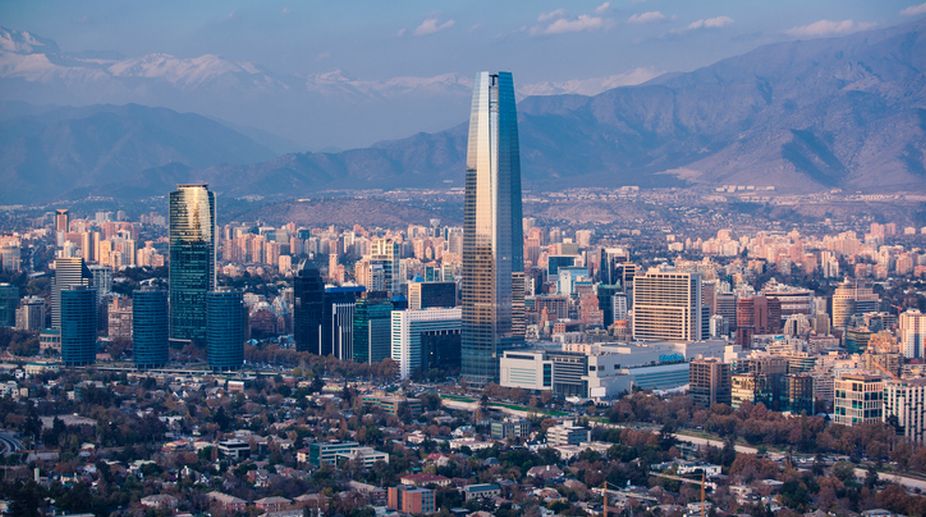MoS Margherita meets Ambassadors of Chile, Myanmar
Minister of State for External Affairs, Pabitra Margherita held a meeting with the Ambassador of Chile, Juan Angulo and He also held a meeting with the Ambassador of Myanmar to India, Zaw Oo.

Financial district in Santiago, Chile (Photo: Getty Images)
In an effort to highlight places of interest in countries across the world, their varied culture, economy and history, The Statesman brings to you a Weekly Focus on countries with which India shares diplomatic ties and friendship. This week’s focus is on Chile. Know all about the country.
Capital: Santiago, Currency: Chilean peso, Language: Spanish 99.5 per cent (official), English 10.2, indigenous 1 (includes Mapudungun, Aymara, Quechua, Rapa Nui), other 2.3 per cent, unspecified 0.2 per cent (2012 est.), Religion: PRoman Catholic 66.7 per cent, Evangelical or Protestant 16.4, Jehovah’s Witness 1, other 3.4, none 11.5, unspecified 1.1 per cent (2012 est.) Ethnic groups: White and non-indigenous 88.9 per cent, Mapuche 9.1, Aymara 0.7, other indigenous groups 1 per cent (includes Rapa Nui, Likan Antai, Quechua, Colla, Diaguita, Kawesqar, Yagan or Yamana), unspecified 0.3 (2012 estimates).
Advertisement
CLIMATE
Advertisement
Due to its long coastline, Chile’s weather is extremely diverse and unpredictable. Summer runs from December to February, and winter from June to August. Temperatures are variable. In the dry, arid Atacama desert in the north, temperatures reach a maximum of 32°C and can drop to -2°C. The central region has a Mediterranean feel with a cold, wet season from May to August, while it is usually always cool and damp in the south. Easter Island has its own humid subtropical temperatures, while much of the south has very high annual rainfall.
QUITE A LONG JOURNEY
It takes 27 hours to fly from Delhi to Santiago. Doha, London, New York, Paris, and Miami are the major layover airports. The Indian community has been present in Chile since 1905. Around 1,500 Indians living in Chile of whom 60 per cent have obtained Chilean nationality. One-third of them live in Iquique and the rest are in Santiago, Valparaiso, Vina del Mar and Punta Arenas. The majority are from the Sindhi community and are engaged in business. In addition, there are always about 500 professionals from India, working mainly in the ICT sector and also in Indian companies represented in Chile. Some Indian labourers are also present in Chile.
Healthy trade ties
While exports from India increased in 2015 and 2016, Chilean exports to India fell due to declining copper prices which is Chile’s main export item to India. High value-added items such as commercial vehicles, motor cars, two-wheelers, and bulk pharmaceuticals have entered the Chilean market. Other traditional items being imported by Chile are garments, handicrafts, textiles, carpets and handtools. India’s imports from Chile are copper, iodine, chemical wood pulp, molybdenum concentrates, and apples. There are 24 Indian companies based in Chile. From 1974 to 2012, India has invested a total of $27.1 million in Chile, basically in mining and IT.
Many Indian companies have recently entered Chile through acquisition of Chilean companies or via joint ventures. These include Jindal Steel Works, TCS, Oracle Fine Services, Wipro, Godrej, Ashok Leyland, Tata Motors and Bajaj Auto.
Cuisine with European flavour
Chile is blessed with an abundance of natural produce. Its cuisine is likewise fresh and hearty, less spicy than most of Latin America, and with a mix of Spanish, French and German influences. Outside of Santiago, options are limited for vegetarians. Seafood, red meat, and chicken dominate the menu. For carnivores, a leisurely asado (barbeque) or curanto (shellfish stew) is an opportunity to participate in a cherished Chilean tradition. Some specialities are Empanada, Cazuela de ave, congrio (conger eel), centolla (king crab), Bifea lopobre, Pastel de choclo and Pebre. Chilean wine is very good, especially the Carmenère, Syrah, Cabernet Sauvignon and Malbec varieties.
EASTER ISLAND & OTHER EXOTICA
Easter Island
Despite being more than 3,500 km away from mainland Chile, this fascinating island with its remarkable stone sculptures remains the country’s most recognisable attraction. All told, 887 of these statues, known as Moai, created by the island’s early Rapa Nui population, have been identified, most of them now protected by Rapa Nui National Park (the island itself has been declared a Unesco World Heritage Site). The most impressive collection is at Ahu Tongariki.
Torres Del Paine National Park
More than 100 km north of the city of Puerto Natales in southern Patagonia, this stunning area encompasses mountains, glaciers, and countless lakes and rivers. The most important region of the park is the Cordillera del Paine. The most notable features is the three 2,850m tall granite peaks of the Paine Massif. Hiking is one of the park’s most popular activities.
Compiled by Kunal Jain (kunaljain@thestatesman.com)
Advertisement